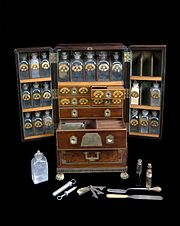
A medicine chest is a container or cabinet for storing medicine. All ships governed by the regulations of the International Maritime Organization must have medical supplies and suitable storage for them such as refrigeration and locks.
In Canada medicine chest has a related, symbolic meaning. Under the terms of Treaty 6 between the Canadian government and several bands of First Nations people ("Indians"), the government was required to supply each Indian reserve with a medicine chest. That has been interpreted as an ongoing responsibility for the government to provide healthcare to First Nations people.
-
 A medicine chest, winged front, from Reece's Medical Hall, Piccadilly, with 30 painted glass bottles and 4 drawers, 5 confection glasses, 1 probang, 3 boxes, 1 plaster spreader, 1 seal, 1 spatula, 1 bowl, 1 pill tile, 1 fleam, 1 lancet, 2 syringes, 4 visiting cards, 1 receipt and engraved plate, circa 1805
A medicine chest, winged front, from Reece's Medical Hall, Piccadilly, with 30 painted glass bottles and 4 drawers, 5 confection glasses, 1 probang, 3 boxes, 1 plaster spreader, 1 seal, 1 spatula, 1 bowl, 1 pill tile, 1 fleam, 1 lancet, 2 syringes, 4 visiting cards, 1 receipt and engraved plate, circa 1805
References
- "The ship's medicine chest". International medical guide for ships: including the ship's medicine chest. World Health Organization. 2007. ISBN 9241547200.
- Transcription of: Cede, Yield and Surrender: A History of Indian Treaties in Canada. aadnc-aandc.gc.ca
This medical article is a stub. You can help Misplaced Pages by expanding it. |